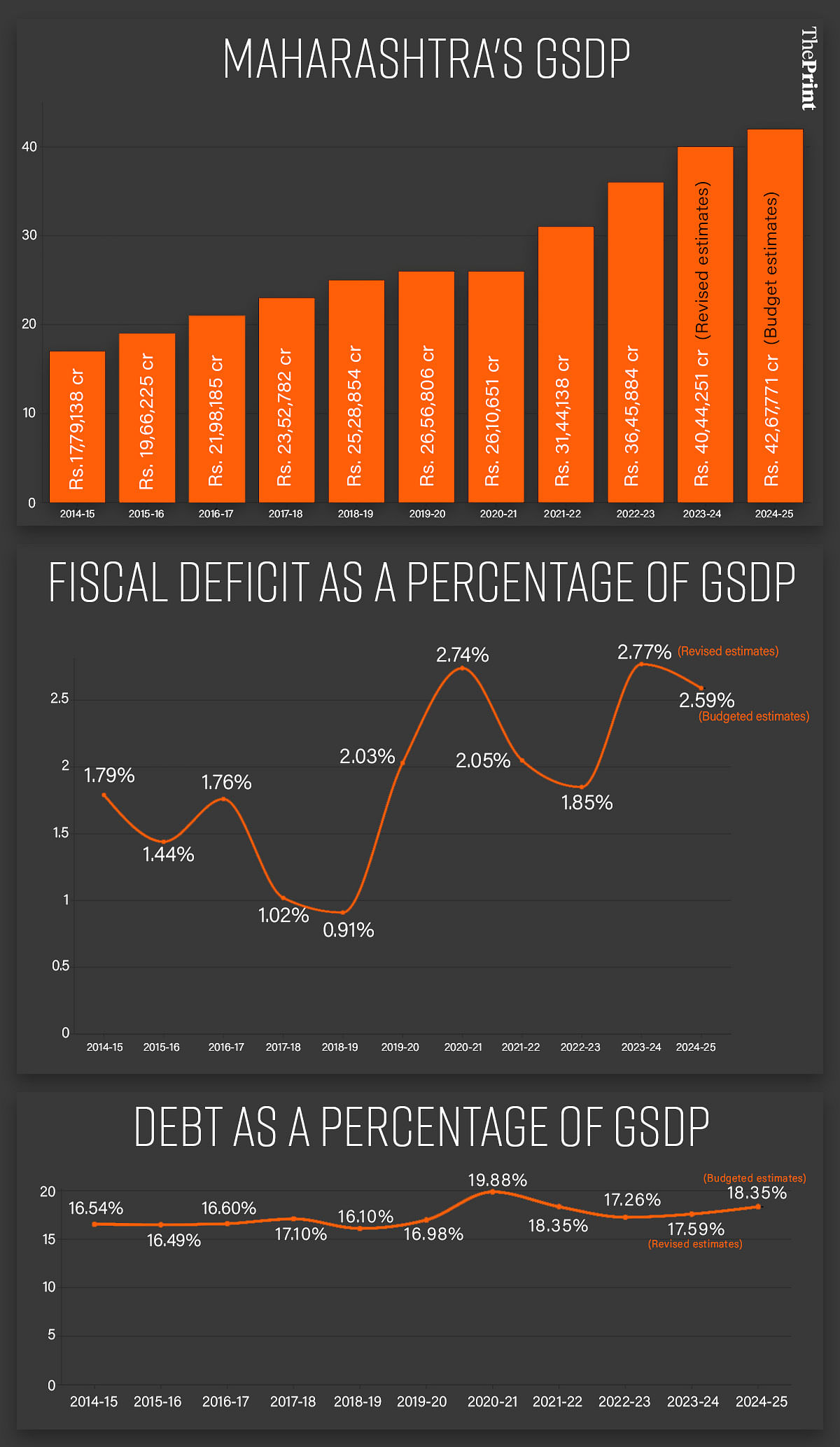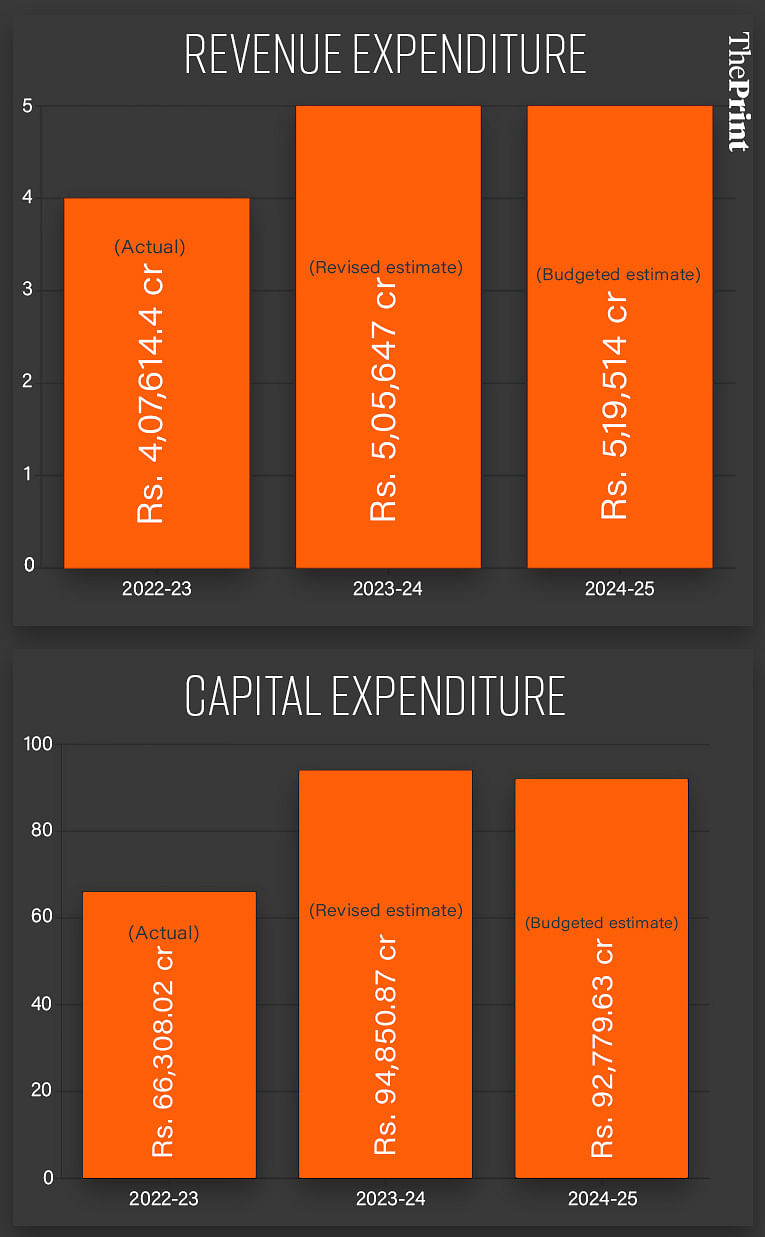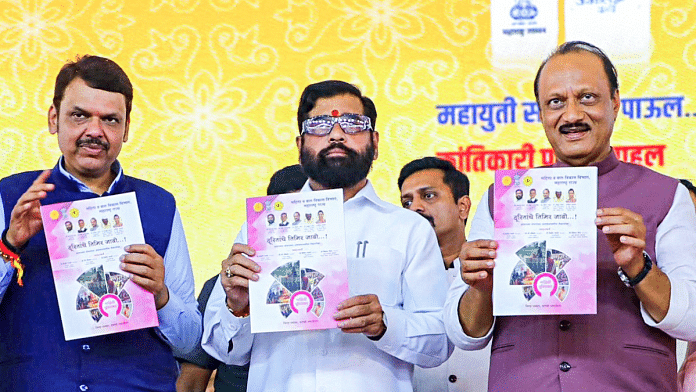Mumbai: Ahead of the Maharashtra polls, the Eknath Shinde-led Mahayuti government is fighting fire from the opposition Maha Vikas Aghadi (MVA) for allegedly leaving the state’s finances in a precarious condition by doling out subsidies and incentives to woo almost every section of the electorate.
A closer look at the numbers, however, show that Maharashtra has headroom to spend, but the volley of schemes passed by the Mahayuti government could limit the state’s ability to ramp up capital expenditure—the amount spent on asset creation—on hard infrastructure. For this fiscal in particular, a rise in interest payments and pensions is also likely to weigh on the state’s overall expenditure, limiting capital expenditure, as per the budget estimates.
The numbers also show that the state’s fiscal deficit and debt have shot up by 63 percent and 24 percent, respectively, but are within the recommended limits as per the 15th Finance Commission.
The Mahayuti comprises the Shinde-led Shiv Sena, the Bharatiya Janata Party (BJP) and the Ajit Pawar-led Nationalist Congress Party (NCP).
“As per the limits set by the 15th Finance Commission, Maharashtra’s fiscal deficit is well within the recommended level. The expenditure on payouts and subsidies has gone up, but if Maharashtra does have the room to spend money, it depends on the priority of every government how it wants to spend that money. This government has clearly defined its priority and that is, in a way, helping the government focus and deliver,” a senior state government official said.
The 15th Finance Commission has recommended a fiscal deficit limit of 3 percent between 2023 and 2026 for states. As per the 2024-25 budgeted estimates for Maharashtra, the fiscal deficit is projected to be at 2.59 percent.
Officials from the state finance department said, the process of calculating the revised estimates for the current fiscal was underway and would be concluded only by February.
Since September, the Mahayuti cabinet has taken 165 decisions in six meetings. Elections will take place on 20 November. In the last two days before the code of conduct came into force in mid-October, 560 government resolutions were passed. The impact of these decisions on the state’s financial health will be clear only once the finance department completes the process of revising budget estimates.
O.P. Gupta, additional chief secretary in charge of the finance department, did not respond to ThePrint’s calls and text message.
The populist schemes and decisions come close on the heels of a lacklustre performance of the Mahayuti in the Lok Sabha polls. The Mahayuti won 17 of Maharashtra’s 48 seats, while the MVA won 30 seats. One constituency went to an Independent candidate, who aligned himself with the MVA.
After the Lok Sabha results, the government announced a multitude of incentives for different target groups. These include its flagship ‘Majhi Ladki Bahin’ scheme under which Rs 1,500 per month is given to eligible women in the age group of 21 to 65 years with an annual family income of less than Rs 2.5 lakh. Deputy CM Ajit Pawar set aside Rs 46,000 crore a year for the scheme.
Other schemes introduced in the budget include free higher education for girls from the economically weaker section and the backward classes, three free of cost gas cylinders for eligible households, financial assistance for cotton, soybean and onion farmers, free electricity for farmers through solar pumps, and an apprenticeship scheme for the youth expected to cost the state Rs 10,000 crore a year.
Debt stock & fiscal deficit
The Aghadi, which comprises the Shiv Sena (Uddhav Balasaheb Thackeray), the Congress and the Ajit Pawar-led Nationalist Congress Party (Sharadchandra Pawar), has often criticised the Mahayuti government for putting a fiscal strain on Maharashtra.
For instance, last month, in a post on social media platform ‘X,’ Baramati MP Supriya Sule said Maharashtra’s deficit had reached “alarming levels, driven by failed economic policies and unchecked spending”.
Earlier this month, Congress state president Nana Patole also said that Maharashtra is facing a fiscal crisis and has to borrow money to pay salaries of its employees.
The government official quoted above said that salaries and pensions have not been affected and the payments are being made as per schedule.
At a press conference Thursday, culture minister Sudhir Mungantiwar, who held the finance portfolio under the Devendra Fadnavis-led government from 2014 to 2019, dismissed the Opposition’s criticism.
“If you go for a blood test, you will not see whether you have 5.5 litres of blood in your body. You will look at the percentage of haemoglobin,” Mungantiwar said, urging people to look at the debt and fiscal deficit as a percentage of Maharashtra’s Gross State Domestic Product (GSDP) rather than in isolation.
The fiscal deficit is estimated to be Rs 1.10 lakh crore this year as against Rs 67,601 crore in 2022-23, the year the Mahayuti came to power. While there has been an increase in the fiscal deficit, even if seen as a percentage of the GSDP, it is still under the recommended 3 percent.
Maharashtra’s fiscal deficit as a percentage of GSDP is estimated to be 2.59 percent this year, up from 1.85 percent in 2022-23. During the MVA rule, it was 2.03 percent in 2019-20, 2.74 percent in 2020-21, and 2.05 percent in 2021-22.

A state government source said the finance department had been putting up adverse remarks on almost every proposal that went to the cabinet. On one of the proposals, it had warned about the shooting fiscal deficit saying that the state cannot accept more financial burden. In the case of yet another proposal by the public works department, it had observed that the state had crossed its fiscal limit for raising loans.
The state government official quoted above said, “The finance department is always known to take a cautious view on proposals. But, largely, if the government has decided to use the fiscal space it has by spending on a focus area, there will naturally be a squeeze on other areas.”
Similarly, while Maharashtra’s debt stock has surged by 166 percent from Rs 2.94 lakh crore in 2014-15 to an estimated Rs 7.82 lakh crore in 2024-25, the rise is not as dramatic if seen through the prism of the GSDP. In 2014-15, the state’s debt as a percentage of GSDP was 16.54 percent, while in 2024-25, it is estimated to be 18.35 percent, the same as in 2021-22, which was the last full year of the MVA government.
As per the Medium Term Fiscal Policy, Fiscal Policy Strategy Statement And Disclosures For Maharashtra 2023-24, the prescribed debt to GSDP ratio is 25 percent.
The GSDP is estimated to be Rs 42.67 lakh crore this fiscal, up from the Rs 36.45 lakh crore in 2022-23 when the Mahayuti government came to power.
During his briefing with reporters, Mungantiwar liked to point to how the GSDP, which has consistently shown an uptick since 2014-15, decreased only once year-on-year, when the MVA government was in power.
In 2019-20, the GSDP was Rs 26.56 lakh crore, while in 2020-21, it dipped to Rs 26.10 lakh crore. The MVA government came to power in November 2019 and had to battle the Covid pandemic from March 2020.
Rising revenue expenditure
Officials from the finance department explained that most of the amount spent on the schemes introduced in the budget would be counted under revenue expenditure as these involve subsidies.
Revenue expenditure—the amount spent for the normal functioning of government departments—forms a bulk of the expenditure incurred by any government. It can be broadly divided into three categories: interest payments on loans, salaries and pensions, and subsidies.

The revenue expenditure is estimated to be Rs 5.19 lakh crore for the current fiscal, 2.7 percent more than the 2023-24’s revised estimate of Rs 5.05 lakh crore.
In the first year of the Mahayuti government, which came to power in June 2022, the revenue expenditure was Rs 4.65 lakh crore, 11.6 percent lower than the projections for 2024-25.
While revenue expenditure has increased this fiscal, the state’s capital expenditure has been slightly squeezed.
The capital expenditure estimated for 2024-25 is lower than the revised expenditure for last year. For 2023-24, according to the government’s revised estimates, it is Rs 94,850.87 crore, while the budgeted capital expenditure for this fiscal is Rs 92,779.63 crore.
Overall, since this government came to power, the capital expenditure has increased from Rs 66,308.02 crore in 2022 to an estimated Rs 92,779.63 crore now.
This year’s dip in capital expenditure is a result of a rise in revenue expenditure due to interest payments and pensions rather than subsidies.
A breakdown of the revenue expenditure shows that the budgeted development expenditure is Rs 3.32 lakh crore, down from last fiscal’s Rs 3.53 lakh crore as per the revised estimates.
On the other hand, the budgeted non-development expenditure, which includes the salaries and routine expenses that go into the functioning of a government, has risen to Rs 1.86 lakh crore.
In 2023-24, the non-development expenditure as per the revised estimates was Rs 1.52 lakh crore. A bulk of the increase, about Rs 23,000 crore, has come from pensions and interest payments.
(Edited by Tony Rai)
Also Read: Why stakes are high for BJP & INDIA bloc as Maharashtra, Jharkhand go to polls
manas






